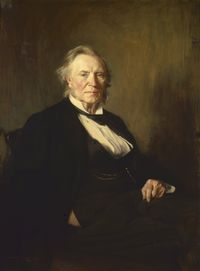Difference between revisions of "Simon Somerville Laurie (1829-1909)"
| Line 1: | Line 1: | ||
| − | [[File:0016094c.jpg | border | | + | [[File:0016094c.jpg | border | 200 px | right | thumb | Simon Somerville Laurie (1829-1909), portrait by George Fiddes Watt (University of Art Collection, EU0095)]]'''Simon Somerville Laurie (1829-1909)''' was the first holder of the [[Bell Chair of Education]] from 1876 to 1903. One of his chief aims was to bring the University and teaching training colleges closer together and, ultimately, to entrust the training of teachers in Scotland to the Universities of Scotland. At the time of his appointment, teacher training in Edinburgh was still the exclusive province of the Church of Scotland and the Free Church of Scotland. It would remain so until the Scottish Education Department established the [[Edinburgh Provincial Training Centre]] at Moray House in 1907. Nonetheless Laurie ensured that good students at the existing [[Church of Scotland Training College]] and [[Free Church of Scotland Training College]] were encouraged to take University classes during their college course and to go on to a degree. It was also due to his influence that a Schoolmaster's Diploma was instituted by the University. This was open to Arts graduates who had attended the University's Education Class, taken a teaching training course at one of the church colleges, and passed an examination in the theory and practice of Education. The Diploma was recognized by the Scottish Education Department as qualifying the holder to teach in Scottish schools. |
== Sources == | == Sources == | ||
Revision as of 15:55, 5 December 2014
Simon Somerville Laurie (1829-1909) was the first holder of the Bell Chair of Education from 1876 to 1903. One of his chief aims was to bring the University and teaching training colleges closer together and, ultimately, to entrust the training of teachers in Scotland to the Universities of Scotland. At the time of his appointment, teacher training in Edinburgh was still the exclusive province of the Church of Scotland and the Free Church of Scotland. It would remain so until the Scottish Education Department established the Edinburgh Provincial Training Centre at Moray House in 1907. Nonetheless Laurie ensured that good students at the existing Church of Scotland Training College and Free Church of Scotland Training College were encouraged to take University classes during their college course and to go on to a degree. It was also due to his influence that a Schoolmaster's Diploma was instituted by the University. This was open to Arts graduates who had attended the University's Education Class, taken a teaching training course at one of the church colleges, and passed an examination in the theory and practice of Education. The Diploma was recognized by the Scottish Education Department as qualifying the holder to teach in Scottish schools.
Sources
- James Drever, 'The New Developments in the Education Department', University of Edinburgh Journal, 1 (1925), 4-8.
